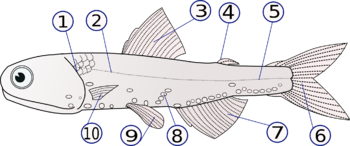Most fish exchange gases using gills on either side of the pharynx. Gills consist of threadlike 
(1) – operculum (gill cover), (2) – lateral line, (3) – dorsal fin, (4) – fat fin, (5) – caudal peduncle, (6) – caudal fin, (7) – anal fin, (8) – photophores, (9) – pelvic fi
structures called filaments. Each filament contains a capillary network that provides a large surface area for exchanging oxygen and carbon dioxide. Fish exchange gases by pulling oxygen-rich water through their mouths and pumping it over their gills. In some fishes, capillary blood flows in the opposite direction to the water, causing counter current exchange. The gills push the oxygen-poor water out through openings in the sides of the pharynx. Some fishes, like sharks and lampreys, possess multiple gill openings. However, most fishes have a single gill opening on each side. This opening is hidden beneath a protective bony cover called an operculum.
Juvenile bichirs have external gills, a very primitive feature that they share with larval amphibians.

Many fish can breathe air via a variety of mechanisms. The skin of anguillid eels may absorb oxygen. The buccal cavity of the electric eel may breathe air. Catfishes of the families Loricariidae, Callichthyidae, and Scoloplacidae absorb air through their digestive tracts.[13] Lungfish and bichirs have paired lungs similar to those of tetrapods and must surface to gulp fresh air through the mouth and pass spent air out through the gills. Gar and bowfin have a vascularized swim bladder that functions in the same way. Loaches, trahiras, and many catfish breathe by passing air through the gut. Mudskippers breathe by absorbing oxygen across the skin (similar to frogs). A number of fishes have evolved so-called accessory breathing organs that extract oxygen from the air. Labyrinth fish (such as gouramis and bettas) have a labyrinth organ above the gills that performs this function. A few other fish have structures resembling labyrinth organs in form and function, most notably snakeheads, pikeheads, and the Clariidae catfish family.
Breathing air is primarily of use to fish that inhabit shallow, seasonally variable waters where the water's oxygen concentration may seasonally decline. Fishes dependent solely on dissolved oxygen, such as perch and cichlids, quickly suffocate, while air-breathers survive for much longer, in some cases in water that is little more than wet mud. At the most extreme, some air-breathing fish are able to survive in damp burrows for weeks without water, entering a state of aestivation (summertime hibernation) until water returns.




0 comments:
Post a Comment